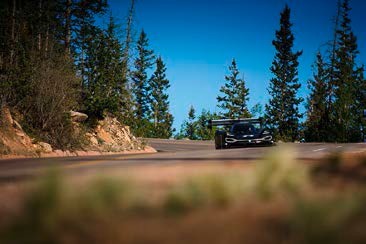
The I.D. R Pikes Peak has completed the first test for the “Pikes Peak International Hill Climb” on the original track in the US state of Colorado.
Driver Romain Dumas was impressed with the performance of the all-electric powered racing car. Since the track to the summit at an altitude of 4,302 metres is a public road, the team only had access to it for three hours. In preparation for further test runs and the race on 24th June, Volkswagen Motorsport has established a base in Colorado.
The news from Colorado is very positive: we are on schedule with the preparations for the I.D. R Pikes Peak and can now focus on the fine-tuning – explained Volkswagen Motorsport Director Sven Smeets. It is the result of a very strong team performance, initially here in Germany and now by our team on site in the USA. If we continue to work with focus and motivation, we are in with a good chance of setting a new record time for e-cars on 24 June.
 During the first test in the USA, the team mainly focused on the suspension, tyre tests, and the optimum use of battery charge and energy recycling when braking.
During the first test in the USA, the team mainly focused on the suspension, tyre tests, and the optimum use of battery charge and energy recycling when braking.
Perfect energy management is one of the key factors for successfully attacking the record in the electric car category – explained François-Xavier Demaison, Technical Director at Volkswagen Motorsport, who, as project manager, is responsible for I.D. R Pikes Peak The first test drive at Pikes Peak was successful. This shows that our computer simulations and the test drives in Europe were on point.
Dumas was delighted after the test.
The I.D. R Pikes Peak is the best car that I have ever driven up this mountain. The acceleration and cornering speed are really impressive, and on top of that the car is very convenient. Thanks to the electric drive, I don’t need to change gears and can focus on the line instead – explained the Frenchman. But it goes without saying that there is always room for improvement. In the remaining test drives, we will continue to optimise the tuning – said Dumas, looking ahead to the coming days and weeks of intensive work in the USA. I know the track at Pikes Peak like the back of my hand, but it is the first time I will be driving a racing car with electric drive. I am learning with every metre I drive in the cockpit of the I.D. R Pikes Peak.
For the 96th edition of the most famous hill climb in the world on 24 June, Volkswagen driver Dumas has his eyes on the time of 8:57.118 minutes – the record for electric cars on the 19.99-kilometre track with 156 turns set in 2016.
This corresponds to an average speed of approximately 134 km/h. The I.D. R Pikes Peak will take on the challenge with a system performance of 500 kW (680 hp), distributed across an electric engine on the front axle and another one on the rear axle.
For the first time, I don’t need to worry about losing power at high altitude – said Dumas, describing the advantages of electric drive compared with standard combustion engines. The low oxygen concentration at high altitudes means that combustion engines lose about 30 percent of their performance when starting at 2,862 metres rather than at sea level. With every kilometre you drive toward the finish line, the effect of the thin air intensifies. In contrast, electric engines work efficiently continuously.
However, other factors are identical for all participants.
You only get one shot – clarified Dumas. If even only the slightest thing goes wrong, a new e-record is highly unlikely. And a lot can go wrong in a hill climb of almost 20 kilometres, which features an altitude difference of 1,440 metres between start and finish. As always in motorsport, the rule is that in order to be first, you have to make it to the finish line – said the Frenchman.
The weather also plays a crucial role.
To set a record, you also need luck with the weather – explained Dumas.
The Pikes Peak International Hill Climb has been called off or shortened due to fog, ice, snow and hail in the past. On average, there is snow or hail at the summit on 18 of 30 days in June. And the drivers may have to deal with a sudden downpour and freezing rain. In the finish area, the average temperature in June is a mere zero degrees Celsius.
Here you can see the video of the test



Be the first to comment